 Q: I recently purchased this large old mask from a Canadian gentleman who had no knowledge of it’s origin or history. I’d guess it to be Eastern European, Tyrolean or possibly Swiss, but I’m not entirely certain where it’s from. I’m hoping you, or one of the many collectors who visit your site, may recognize it. It shows signs of use and has holes around the perimeter indicating it may have had a cloth or fur hood at one point. It also has a concave area surrounded by holes on the back that most likely held padding in place for the comfort of the wearer. It measures approx 14″X 9″, medium weight wood, and has an attached nose. Dan, 929
Q: I recently purchased this large old mask from a Canadian gentleman who had no knowledge of it’s origin or history. I’d guess it to be Eastern European, Tyrolean or possibly Swiss, but I’m not entirely certain where it’s from. I’m hoping you, or one of the many collectors who visit your site, may recognize it. It shows signs of use and has holes around the perimeter indicating it may have had a cloth or fur hood at one point. It also has a concave area surrounded by holes on the back that most likely held padding in place for the comfort of the wearer. It measures approx 14″X 9″, medium weight wood, and has an attached nose. Dan, 929
A: I believe it is a Tschaggatta mask from an isolated rural area of German-speaking Switzerland. The Lötschental valley is famous for its unique local custom involving the so-called Tschäggättä: frightening figures wearing furs and carved wooden masks that walk the streets during carnival tossing soot at their unsuspecting victims. This one has a long crooked nose and a patina that suggests old age. The fur wig is missing. Whether or not it had padding on the rear, I don’t know. A nice piece for a serious collector or museum. A
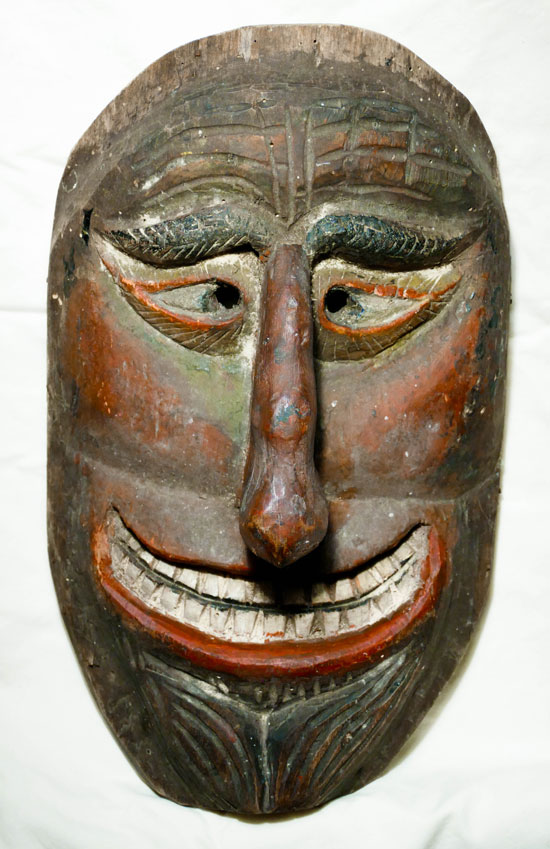
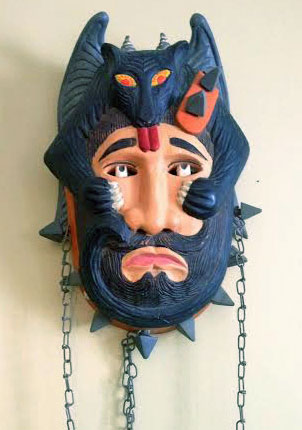
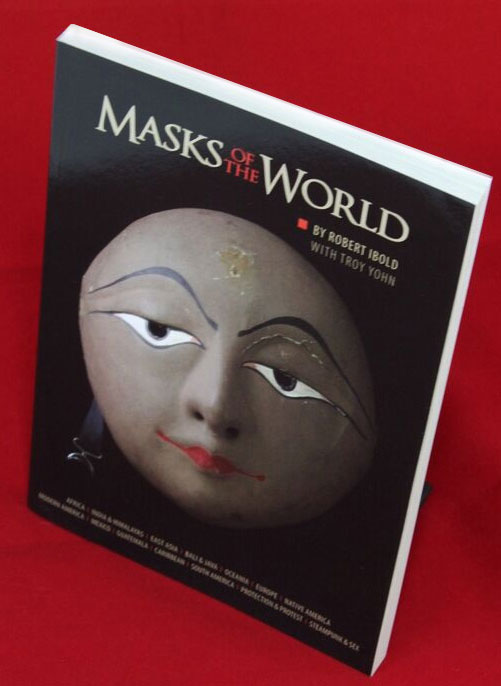
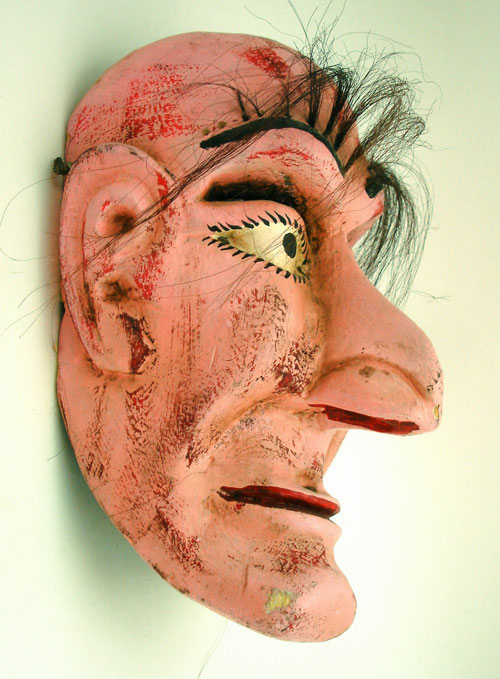
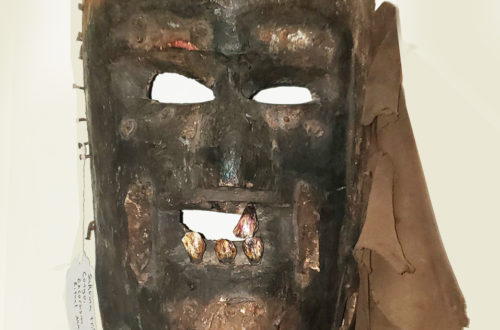
11 Comments
Chris
Wow, this is indeed a find, I can tell you. As I am Swiss and a little more informed about swiss mask, I am quite convinced that this is an old to-be-worn and used Tschäggättä mask from the Lötschen Valley (although I did not see the rear). A rough guess would be 1920s to 1950s (the colours, the overall shape and the smiling mouth indicate such an age). There was clearly fur attached at some time, which is normal for these masks. If it is indeed a real, worn Tschäggättä, it is very rare and worth a LOT – museum piece. Take care of it. greets, chris
Dan
Thanks for the information Bob & Chris!
I thought it could be an old Buso, Swiss or Austrian mask. I’d be very pleased If it’s a genuine Tscaggatta, as you suggest.
Kuhn, Konrad
It is definitely a Tschäggättä mask – the smiling mouth is an indication for it’s origin from Blatten (which is the last of a total of four villages in the valley of Lötschen). I would date it around the 1930s. Definitely highly valuable and a masterpiece in your collection! All the best, Konrad
Sally Wood
I’m very intrigued by this, as my mum’s paternal side is German. We were born there and lived there for some of our childhood years. I’m an artist, currently working on an ancient worlds masks project (for a client). I came across this Tschäggätta mask, while searching for a more ‘rudimentary’ smiling mask (unpainted, cocked, toothy smile). I’ll have luck this week and may ask for help from your experts. Bravo! Sally
Aaron
It actually is a Hungarian Busó mask. I’m not sure why it’s being identified as Swiss, but the mouth, eyes and eyebrows make me 100% sure it’s Hungarian.
Aaron
Here is my basis for believing it’s Hungarian. Compare, Busó masks:
http://budapestlocal.com/wp-content/uploads/2015/12/farsang_ws.jpg
http://www.funzine.hu/wp-content/uploads/2012/08/bus%C3%B3.jpg
http://insider.corinthia.com/wp-content/uploads/2015/10/Budapest-Carnival-_-Busos-2.jpg
with Tschäggättä masks:
https://s-media-cache-ak0.pinimg.com/736x/6e/76/50/6e7650adfa0b2a90f5a107873aefbb56.jpg
http://farm2.static.flickr.com/1455/24540371100_968494a098.jpg
http://mw2.google.com/mw-panoramio/photos/medium/50208007.jpg
Bob Ibold
I got my information from a 1959 book called “Masken Schemen Larven” by Claus Hansmann.
Aaron
If that’s the case, there must be some intense and widespread cross-fertilization going on in that region, because Móhacs is over 1100 kilometers from Lötschental–about the same distance as that between San Francisco and Salt Lake City!
Chris
Aaron’s argumentation has indeed some strength, I must admit. Maybe we could solve the mystery by looking at the kind of wood the mask was made of. As far as I know, Tschäggättä mask wood from Lötschental has ever been the cembra pine, maybe the highest-growing trees in the Alps. That wood has very distinctly marked growth/yearly rings and is quite light-weight. If some specialist in wood would determine that mask’s wood as clearly cembra pine, this would strongly indicate towards Lötschental. However, I have to give credits to Aaron’s point as of the shape of the eyes and of that strange beard…and the smile is evident as well in those masks from Hungary. These features could well be from Hungria. So….interesting case, folks! 🙂
Chris
Hello
after some years of research on Swiss masks and collecting, now am almost 100% sure that Konrad Kuhn is right and it is a genuine Lötschental Tschäggättä facemask, probably from the village of Blatten, or at least taking the Blatten masks as inspiration. It is nevertheless very unusual that the eyebrows and the eyes themselves have these fine incisions – actually the only doubt that i can find. However, Tschäggättä masks can be VERY different in style. Nevertheless, the style of the mask is very typical of the old Blatten-based Tschäggättä. It also bears the very typical rough and unpainted rim on the upper head, where the jute tissue and/or fur was nailed onto the mask. The painting looks also matching to me. would be interesting to have the rear photo…
Also to say that Aaron’s comparison is not valid, as the Swiss mask photo shows only a Tschäggättä of the newer i would say post-1970s style, which is more Hollywood-science-fiction moster style, not a plain and smiling face, as it was often the case in the far past.
So, Dan’s mask is highly valuable and definitely a keeper 🙂
Chris
PS: I forgot to comment about the attached nose: another indicator of an old Tschäggättä – the carvers used to take a rather flat piece of sawed wood plank, which was not thick enough to carve out a portruding nose. And taking all that wood away from a thick piece of wood would have been hard work for those rather poor people with very simple instruments. therefore, it was way easier to attach a piece of wood (mostly by a fat nail) and carve a nose out of it.
Cheers, Chris